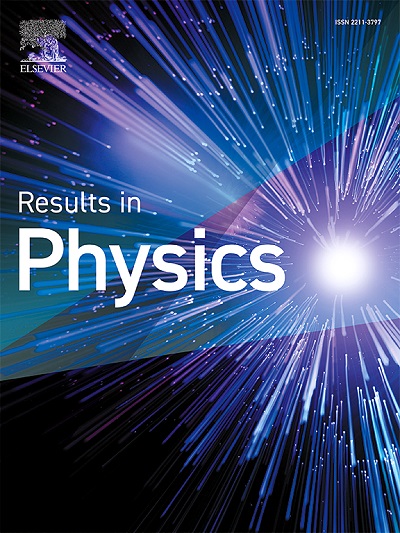Ni掺杂对Ca(OH)2纳米粒子性能的影响及其在有毒亚甲基蓝染料脱除中的应用
IF 4.6
2区 物理与天体物理
Q2 MATERIALS SCIENCE, MULTIDISCIPLINARY
引用次数: 0
摘要
本文报道了用一种简单的共沉淀法成功合成了氢氧化钙纳米颗粒(CHNPs),并在其上掺杂了不同浓度(3-12原子%)的Ni。采用各种表征技术对CHNPs和掺镍氢氧化钙纳米颗粒(Ni-CHNPs)样品进行了结构、元素、官能团、表面形貌、热分析和光学分析。结构分析证实,Ni离子有效地结合到Ca(OH)2晶格中,而不破坏其晶体完整性。通过XPS和EDX光谱进一步证实了Ni在CHNPs中的掺杂。Ni- chnps的晶体尺寸和光学带隙随Ni掺杂浓度的变化而变化。此外,在表面形貌和热重数据中观察到镍掺杂的影响。从Ni与CHNPs相互作用的角度讨论了Ni-CHNPs在不同Ni浓度下性能的变化。然后用合成的材料对废水中染料的吸附量(qe)和去除率(%R)进行了研究。此外,温度对Ni-CHNPs对亚甲基蓝(MB)染料的吸附特性的影响表现为(%R)和(qe)随温度从25℃升高到45℃而持续增加。其中,样品含9个at。% Ni在45°C时表现出最高的吸附效率,达到约90%的染料去除率。采用多种动力学模型对染料的吸附动力学进行了分析,其中伪二阶(PSO)模型最能描述对MB的吸附。这些结果为Ni-CHNPs的性质及其在染料去除方面的潜在应用提供了有价值的见解,为进一步开发环境修复技术提供了参考。本文章由计算机程序翻译,如有差异,请以英文原文为准。
Effect of Ni doping on the properties of Ca(OH)2 nanoparticles and its application in toxic methylene blue dye removal
This work reports the successful synthesis of calcium hydroxide nanoparticles (CHNPs) and doped it with various concentrations (3–12 atom%) of Ni, using a simple co-precipitation method. The CHNPs and nickel-doped calcium hydroxide nanoparticles (Ni-CHNPs) samples were examined for their structural, elemental, functional group, surface morphology, thermal, and optical analysis using various characterization techniques. Structural analysis confirmed that Ni ions were effectively incorporated into the Ca(OH)2 lattice without disrupting its crystalline integrity. The Ni doping in CHNPs is further confirmed by XPS and EDX spectra. The crystallite size and optical band gap of Ni-CHNPs were found to vary with a change in the doping concentration of Ni. Further, the effect of Ni doping was observed in surface morphology and thermogravimetric data. The changes in the properties of Ni-CHNPs with varying concentrations of Ni were discussed in terms of the interaction between Ni and CHNPs. The synthesized material was then used to study the adsorption capacity (qe) and percentage removal (%R) of dyes from wastewater. Furthermore, the effect of temperature on the adsorption characteristics of methylene blue (MB) dye by the Ni-CHNPs is marked by a consistent increase in (%R) and (qe) as the temperature rises from 25 °C to 45 °C. Among these, the sample with 9 at.% Ni showed the highest adsorption efficiency at 45 °C, achieving ∼ 90 % dye removal. The adsorption kinetics of dye were analyzed using several kinetics models, out of which the adsorption of MB was best described by the pseudo-second order (PSO) model. These results provide valuable insights into the properties of Ni-CHNPs and their potential applications in dye removal for further development in environmental remediation technologies.
求助全文
通过发布文献求助,成功后即可免费获取论文全文。
去求助
来源期刊

Results in Physics
MATERIALS SCIENCE, MULTIDISCIPLINARYPHYSIC-PHYSICS, MULTIDISCIPLINARY
CiteScore
8.70
自引率
9.40%
发文量
754
审稿时长
50 days
期刊介绍:
Results in Physics is an open access journal offering authors the opportunity to publish in all fundamental and interdisciplinary areas of physics, materials science, and applied physics. Papers of a theoretical, computational, and experimental nature are all welcome. Results in Physics accepts papers that are scientifically sound, technically correct and provide valuable new knowledge to the physics community. Topics such as three-dimensional flow and magnetohydrodynamics are not within the scope of Results in Physics.
Results in Physics welcomes three types of papers:
1. Full research papers
2. Microarticles: very short papers, no longer than two pages. They may consist of a single, but well-described piece of information, such as:
- Data and/or a plot plus a description
- Description of a new method or instrumentation
- Negative results
- Concept or design study
3. Letters to the Editor: Letters discussing a recent article published in Results in Physics are welcome. These are objective, constructive, or educational critiques of papers published in Results in Physics. Accepted letters will be sent to the author of the original paper for a response. Each letter and response is published together. Letters should be received within 8 weeks of the article''s publication. They should not exceed 750 words of text and 10 references.
 求助内容:
求助内容: 应助结果提醒方式:
应助结果提醒方式:


